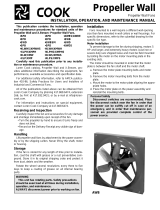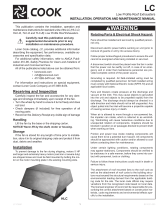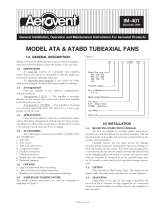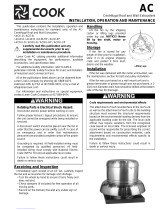
M0112
1
INSTALLATION, OPERATION AND MAINTENANCE MANUAL
WALL EXHAUST FANS BELT & DIRECT DRIVE
XB, HV, HVA, ADD, DDS, DDP
The purpose of this manual is to aid in the proper installation and operation of the
fans. These instructions are intended to supplement good general practices and are not
intended to cover detailed instruction procedures. It is the responsibility of the
purchaser to assure that the installation and maintenance of this equipment is handled
by qualified personnel.
Inspect all shipments carefully for damage. THE RECEIVER MUST NOTE
ANY DAMAGE ON THE CARRIER’S BILL OF LADING AND FILE A CLAIM
IMMEDIATELY WITH THE FREIGHT COMPANY.
INSTALLATION
1. Cut and frame the appropriate wall opening. Fans mounted to a wall require a
different wall opening than fans mounted in cabinets or sleeves. For specific
dimensions, refer to the submittal drawing for the specific fan configuration.
2. Mount the fan in the opening with the fan panel directly over the load bearing
support and if this is not practical angle supports must be provided to transfer
the fan weight to the load bearing structure.
3. Caution: The fan contains rotating parts and requires electrical service.
Appropriate safety precautions should be taken during installation, operation
and maintenance.
4. Warning: Do not install or operate this fan in an environment where
combustible materials, gasses or fumes are present unless it was specifically
designed and manufactured for that application.
5. A damper, if used, should be securely mounted in a manner that allows free and
unobstructed operation.
6. All electrical work must be done, in accordance with all applicable electrical
codes, by a qualified electrician.
7. Prior to wiring ensure the power supply is locked in the OFF position and that
the motor nameplate voltage and the supply voltage match.

M0112
2
8. Be sure to keep all wiring clear of any rotating parts.
9. Before starting the fan ensure that the wheel rotates freely.
10. Tighten all nuts; bolts and setscrews prior to fan start up.
11. On belt driven fans make sure that the belts are tensioned and aligned correctly.
12. Ensure that all protective guards and other safety devices are installed properly
prior to fan start up.
Wiring Instructions
A qualified electrician in accordance with all local and National Electrical Codes
should do all wiring. Lock off all power sources before any wiring is to be
performed. Leave enough slack in the wiring to allow for motor movement when
adjusting the belt tension. Excess wire must be restrained in order to prevent it from
entering the shaft and propeller area. Disconnect switches are recommended and should
be located near the fan in order to, swiftly cut off power in case of an emergency and
maintain complete control of the power source. Some motors may have to be removed
in order to make the connections in the motor terminal box. Follow the wiring diagrams
on the motor nameplate.
1. Wall Fans
• Extend the proper gauge wire to the fan motor.
• Restrain excess wire from entering the shaft and propeller area
.
2. Wall Fans with Cabinets
• Remove guard from cabinet.
• Drill a hole through the cabinet at a convenient location and pull the
wires through (never wire through the guard).
• Restrain excess wire from entering the shaft and propeller area
OPERATION
Pre Start Inspection
• Lock out all power sources
• Inspect all fasteners and set screws and tighten as required
• Inspect belt alignment and tension
• Confirm power source voltage and motor voltage are the same and
that the motor is wired correctly
• Rotate the fan blade to ensure that neither the fan blade nor the belts
come into contact with the housing
• Inspect the fan and the ductwork to ensure they are free of debris
• Check to ensure that all guards and accessories are securely mounted
• Check to be sure the propeller rotation is correct

M0112
3
Typical Installation
Refer to page 8
Start Up
Turn the fan on and inspect for the following.
• Direction of rotation
• Improper motor amperage
• Excessive Vibration
• Unusual Noise
• Improper belt tension or alignment
If a problem is discovered shut off the fan and refer to the section on
troubleshooting to discover the cause of the problem. The fan should be inspected after
30 minutes, 8 hours and 24 hours of operation to ensure all fasteners are tight and belts
are properly tensioned and aligned.
MAINTENANCE
WARNING
Disconnect and secure to the OFF position all electrical power to the fan prior to
inspection or servicing. Failure to comply with this safety precaution could result in
serious injury or death.
• Ventilators should be checked at least once a year. For critical or severe
applications a routine check every two to three months is suggested.
• When removing or installing a belt don’t force the belt over the sheave. Loosen
the motor mount so that the belt can be easily slipped over the sheave.
• The belt, on belt driven units, should be removed and carefully checked for
cracks, ply separation or irregular wear. A small irregularity in the contact
surface of the belt will result in noisy operation. If any of these defects are
apparent the belt should be replaced. At the same time check the sheaves for
chips, dents or rough surfaces that could damage the belt.
• The correct belt tension is important. Too tight a belt will result in excess
bearing pressure, which can cause premature bearing failure and may cause the
motor to overload, too loose a belt will result in slippage, which will burn out
belts. Proper belt deflection should be 1/64” (half way between sheave centers)
for each inch of belt span when a force of approximately 5 lbs. is applied.
• The belt alignment should be checked to be sure that the belt is running
perpendicular to the rotating shafts. Motor and drive shafts must be parallel.
• A periodic inspection of all fasteners should be carried out to ensure they have
not loosened due to vibration. Particular attention should be paid to fasteners
attaching the wheel to the shaft and those attaching the shaft to the bearing.

M0112
4
• The standard pillow blocks on belt driven fans are factory lubricated. These
bearings should be lubricated on a semi annual basis (more frequently in severe
applications) using a high quality lithium based grease. With the unit running
add grease very slowly, using a manual grease gun, until a slight bead of grease
forms at the seal. Be careful not to unseat the seal by over lubricating or by
using excessive pressure. When the bearings are obstructed from view use no
more than three injections with a hand operated grease gun
• Dust and dirt on the exterior surface of the motor, fan panel and the entire fan
wheel should be removed, at intervals determined by the severity of the
application, to ensure proper service life and safety.
• For additional safety information refer to AMCA publication 410-96,Safety
Practices for Users and Installers of Industrial and Commercial Fans
.
Belt Tension
Belt and Pulley Replacement
In the course of regular maintenance the belts and pulleys may have to be
changed and or adjusted the recommended procedure is as follows.
• Do not change the pulley pitch diameter in order to tension the belts.
This will result in a change in the fan speed.
• Loosen the nuts on the motor plate or motor in order to reduce the belt
tension such that the belts will easily slip over the pulleys. Never force
the belts over the rim of the pulley.
• Loosen the setscrews on the pulleys and remove from either the motor or
fan shaft using a two or three jaw puller.
• Remove any shaft imperfection such as setscrew mark using a file or
emery cloth.
• Install the replacement pulleys tightening all setscrews to the
recommended torque rating (see chart) and ensuring that they are
properly aligned.
• Pulley alignment is achieved by moving the pulleys on their respective
shafts or moving the entire motor until the pulleys are correctly aligned
(see figure). Using a square with one edge parallel to the motor shaft
adjust the pulleys until the other edge is parallel to the belts.
• Slip the belts over the pulleys then adjust the motor/ motor plate until
the proper tension is reached (1/64” deflection, half way between pulley
centers, per inch of belt span when pressed firmly).
• Tighten the motor plate/ motor adjusting nuts in place.

M0112
5
Pulley Alignment
INCORRECTINCORRECT
INCORRECTCORRECT
Recommended Torque for Setscrews/Bolts (inch/lbs)
Bearings Replacement
Canarm/LFI Ltd. uses pillow block bearings.
• Before removing the bearings mark the positions of the fan blade,
bearings and pulley on the shaft.
• Note the clearance between the fan blade and the venturi.
• Remove the pulley and fan blade from the shaft using a puller.
• Unbolt the bearings and remove the shaft and pillow blocks as one unit.
• Clean the shaft and remove any marks using a file or emery cloth then
remove the bearings using a bearing puller.
• Inspect the shaft and replace if necessary.
• Mount the new bearings on a section of the shaft that is not worn by
tapping the inner ring face using a soft mallet.
• Align the setscrews on the bearings and then tighten one setscrew on
each bearing.
• Loosely install the bearings on the bearing mount.
• Rotate the shaft to find the center of free movement.
• Install the propeller adjusting the bearing location to center the blade in
the venturi.
SETSCREWS
RECOMMENDED
TORQUE INCH-LBS
HOLD DOWN BOLTS
SIZE
HEX
KEY
MIN
MAX
SIZE
TORQUE
INCH-LBS
NO.10
3/32”
28
33
3/8”-16
240
1/4"
1/8”
66
80
1/2"-13
600
5/16”
5/32”
126
156
5/8”-11
1200
3/8” 3/8”
3/16”
228
275
3/4 “-10
2100
7/16”
7/32”
348
384
7/8”-9
2040
1/2"
1/4"
504
600
1”-8
3000
5/8”
5/16”
1104
1200
1-1/8”-7
4200
3/4"
3/8”
1440
1800
1-1/4”-7
6000

M0112
6
• Tighten the bearing bolts to the proper torque rating (see chart)
• Turn the propeller by hand the propeller should rotate freely with the
same resistance as before the bearing bolts were tightened.
• Tighten all setscrews to the proper torque rating (see chart)
• Install pulley and adjust belt tension.
You should go through the start up steps as outlined above.
PARTS LIST
MODELS: DDS, DDP, ADD
MOTOR 1
WELDED FAN ASSEMBLY
PROPELLER BUSHING
FAN ASSEMBLY
PROPELLER
DESCRIPTION QUANTITY
1
1
1
1
3
2
ITEM
4
4
3
2
1
PARTS LIST
MODELS: XB, HV, HVA
DRIVEN SHEAVE BUSHING
MOTOR SHEAVE BUSHING
FAN ASSEMBLY
PILLOW BLOCK BEARINGS
3
DRIVEN SHEAVE
"V" BELTS
FAN SHAFT
PROPELLER
PROPELLER BUSHING
9
11
10
6
8
7
5
4
DESCRIPTION
MOTOR SHEAVE
ITEM
2
1
1
2
2
1
1
1
1
1
1
QUANTITY
1
1WELDED FAN ASSEMBLY
MOTOR
4
11
9
10
6
8
7
5
2
3
1

M0112
7
FAN TROUBLE SHOOTING GUIDE
PROBLEM POSSIBLE CAUSES
Impeller or sheaves loose
Belts not tensioned properly
Bent shaft
VIBRATION Out of balance impeller
Loose fasteners
Loose or worn bearings
Drive misalignment
Fan not properly installed
Mismatched belts
Out of balance sheaves
Improper fan installation
Static pressure higher than design
MOTOR OVERLOADING Impeller rotating in the wrong direction
Improper fan speed
Defective motor
Fan speed higher than design
Filters missing
TOO MUCH AIR Static pressure lower than design
Fan speed higher than design
Lack of electricity to the fan
Fan wired improperly
Broken or missing belt
FAN DOES NOT OPERATE Missing or blown fuses
Overload protection has broken circuit
Defective motor
Impeller or sheaves loose
Belts not properly tensioned
Sheaves not properly aligned
Impeller out of balance
Sheaves out of balance
EXCESSIVE NOISE Bent shaft
Bearings defective or need lubrication
Worn belts
Vibration or lack of isolation
Loose fasteners
High velocity air

M0112
8
TYPICAL INSTALLATIONS
Wall exhaust fan with cabinet, back guard and shutter
The above drawing illustrates the typical installation of an exhaust fan with cabinet,
back guard and shutter in a masonry wall. The installer shall provide angle iron framing
and suitable fasteners (hex bolts or lag screws) to support the fan. The cabinet and
framing should be caulked to the exterior wall. Fans with motors in excess of 50
pounds should also be supported using hanging rods or by supports placed underneath
the fan.
ANGLE IRON
SUPPORTS
BY OTHERS.
A
WO
B
EXHAUST WALL FAN C/W CABINET, SHUTTER AND BACKGUARD
DDS,DDP,ADD
48 48
60
54
-
-
-
-
42
36
30
24
-
-
-
XB,HV,HVA
18
30
42
36
24
20
12
16
14
53 7/8
26*
54 7/8
59 7/8
+ For 15 hp and 20 hp add 8"
* For 7 1/2 hp and 10 hp add 6"
69
60 7/8
26*+
26*+ 68
47 7/8
41 7/8
35 7/8
29 7/8
24 1/4
22 1/4
20 1/4
18 1/4
16 1/4
23 1/4
36 7/8
48 7/8
42 7/8
30 7/8
25 1/4
17 1/4
21 1/4
19 1/4
WO
16
26
26*
26
26
16
16
16
16
A B
Wall supply fan with cabinet, back guard, motorized shutter and weather hood
The above drawing illustrates the typical installation of a supply fan with a cabinet,
back guard, motorized shutter (with end switch), and weather hood in a masonry wall.
The installer shall provide angle iron framing and suitable fasteners (hex bolts or lag
screws) to support the fan. The cabinet and framing should be caulked to the exterior
wall. The weather hood can either be attached to the cabinet or fastened to the wall and
then caulked. These fans should either be supported by hanging rods or by supports
placed underneath the fan.
ANGLE IRON
SUPPORT BY OTHERS
E
WO
A
B
D
C
Hood Free Area
ANGLE IRON SUPPORTS BY
OTHERS.

M0112
9
SUPPLY WALL FAN C/W EXT. CABINET BACKGUARD, MOTORIZED 3200 SER. SHUTTER AND WALL HOOD
2424
54
60
48
42
36
30
-
-
48
36
42
30
38+
38+
32*
32*
32
32
32
DDS,DDP,ADD
-
-
-
-
XB,HV,HVA
-
14
18
20
16
12
WO
22
22
22
22
A
22
20 1/2
20 1/2
14 1/2
D
11
11
11
11
11
B C
30 7/8
36 7/8
42 7/8
48 7/8
54 7/8
60 7/8
69
25 1/4
17 1/4
19 1/4
21 1/4
23 1/4
36 1/4
42 1/4
48 1/2
30
69
54 1/2
61
73 1/4
65 1/4
58 1/2
52 1/2
46 1/4
40 1/4
34
16 1/2
22 1/2
24 1/2
20 1/2
18 1/222 1/2
28 1/2
26 1/2
24 1/2
20 1/2
+ For 15 hp and 20 hp add 8"
* For 7 1/2 hp and 10 hp add 6"
53 7/8
68
59 7/8
22 1/4
47 7/8
41 7/8
35 7/8
29 7/8
24 1/4
20 1/4
18 1/4
16 1/4
E
14 1/2
14 1/2
14 1/2
14 1/2
WARRANTY
Canarm/LFI Limited warrants this equipment to be free from defects in material
and workmanship for a period of one year from the date of sale. The motor
manufacturer warrants motors for a period of one year. Should motors, supplied by
Canarm/LFI Limited, prove to be defective during the warranty period they should be
returned to the nearest authorized motor manufacturer’s warranty depot.
Any fans or parts, which prove to be defective during the warranty period, will be
repaired or replaced at our option when returned to our factory transportation prepaid.
A return authorization number, that is to be obtained our customer service department,
must accompany all returns to Canarm/LFI Limited.
Canarm/LFI Limited will not be responsible for any removal or installation costs.
CANARM LTD.
2157 Parkedale Avenue, Brockville, Ontario K6V 5V6 Canada
Ph: (613) 342-5424
Fax: (613) 342-8437
www.canarm.com
July 2003
-
 1
1
-
 2
2
-
 3
3
-
 4
4
-
 5
5
-
 6
6
-
 7
7
-
 8
8
-
 9
9
Ask a question and I''ll find the answer in the document
Finding information in a document is now easier with AI
Related papers
-
Canarm P12-4 Owner's manual
-
Canarm BTA42T30200M Owner's manual
-
Canarm Industrial Installation Instructions Manual
-
Canarm CJF-AC-EC Series Installation guide
-
Canarm ALX105-UD Operation Instructions Manual
-
Canarm SD24-F1 Standard Exhaust Fans User manual
-
Canarm CNFRMC5 Operating instructions
-
Canarm CNFRMC5 Owner's manual
-
Canarm CN5041 User guide
-
Canarm CN5151 Operating instructions
Other documents
-
 COOK EWB Installation, Operation and Maintenance Manual
COOK EWB Installation, Operation and Maintenance Manual
-
 COOK EWB Installation guide
COOK EWB Installation guide
-
Carrier 09FA User manual
-
Greenheck Fan Hooded Propeller Roof Fans User manual
-
 COOK LC series Installation, Operation and Maintenance Manual
COOK LC series Installation, Operation and Maintenance Manual
-
Greenheck 471755 Sidewall Propeller Fans Operating instructions
-
FläktGroup Centrimaster GT Installation guide
-
 Aerovent ATABD series Installation, Operation And Maintenance Instructions
Aerovent ATABD series Installation, Operation And Maintenance Instructions
-
 Loren Cook ACRU-B Installation, Operation and Maintenance Manual
Loren Cook ACRU-B Installation, Operation and Maintenance Manual
-
Dodge 1VP-2VP Key Type Sheaves Operating instructions













